The Developmental Mathematics Series
After teaching Calculus, Precalculus, and Developmental Mathematics courses, I felt the jump in content from developmental mathematics to college-level mathematics was severe. In addition, the students that I had in my Precalculus course did not have the study skills necessary to be successful math students. So, I decided to write my own developmental mathematics series to address these concerns.
Most math students go through the following process when taking a math class.
- Attend class and watch the instructor do problems on the board (and thinking to themselves, “this is easy”.
- Go home and immediately start working problems.
- Eventually get stuck on a problem and possibly look in the text for an example just like the one stuck on.
- Quit when the level of frustration reaches the boiling point.
When we sat down to write this text we asked two questions:
- How can we get students to read the material between the end of section exercises and learn how to “Do the Math”?
- How can we bridge the gap between developmental mathematics and college-level mathematics?
The solution for the first problem was the Quick Check exercises. The idea behind the Quick Check exercise is best explained using a metaphor. When we first learn to ride a bicycle, we have training wheels to help us keep balanced. The Quick Check exercises immediately follow the corresponding examples in the text itself. These Quick Check exercises were to be assigned as homework for the student to complete. By assigning the Quick Checks as homework, the student is (a) forced into the text to do his/her homework, and (b) has access to the example that corresponds to the Quick Check exercise. Notice how the annotations in Example 3 appear to the left of the mathematics. The annotations act like the instructor’s voice and mimics the way we read, “from left to right”. In addition, Example 3 immediately precedes Quick Check exercises 11 thru 13. If a student gets stuck on Problem 12, they should reference Example 3. The location of the Quick Check exercise helps the student keep balanced.
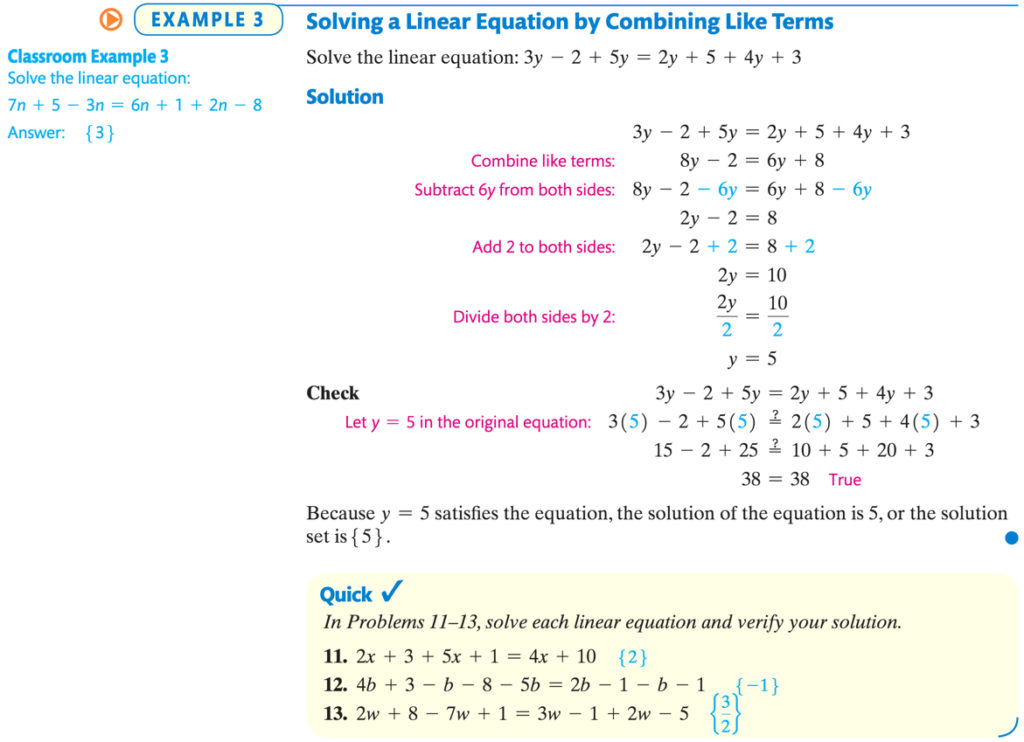
After training wheels comes the child riding with an adult holding his/her back. The Building Skills exercises at the end of the section are tied to an objective in the text, so the student knows which objective to go to for help (trying to ride on own, but some assistance). Lastly, the child rides on his/her own. These are the Mixed Practice and Application problems in the end of section exercises.
We also have How-To or Showcase examples. In ShowCase examples, we always write the step and then show the corresponding mathematics. This helps the student understand how each step works through the example.
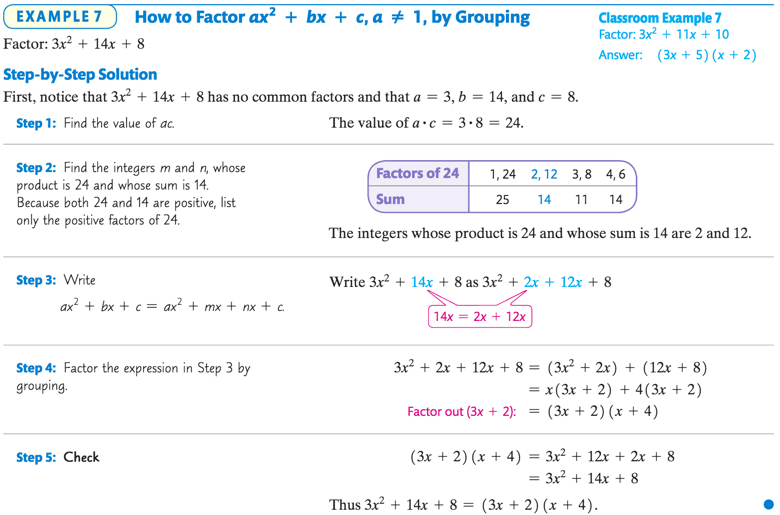
Recall, the second problem we wanted to address was to bridge the gap between developmental mathematics and college-level mathematics. The solution for this problem was to introduce topics in developmental math typically reserved for later courses, but definitely accessible to a developmental math student. After all, we don’t want students to think this course is a rehash of their high school math. So, we often present topics that are reserved for college level mathematics, but present the topics through the lens of Developmental Mathematics. This is not to suggest that this is a high-level text, it’s just that we are bringing topics in that developmental math students can handle, but may not have seen in prior mathematics courses. This is done to prevent a sense of over-confidence and complacency on the part of the student.
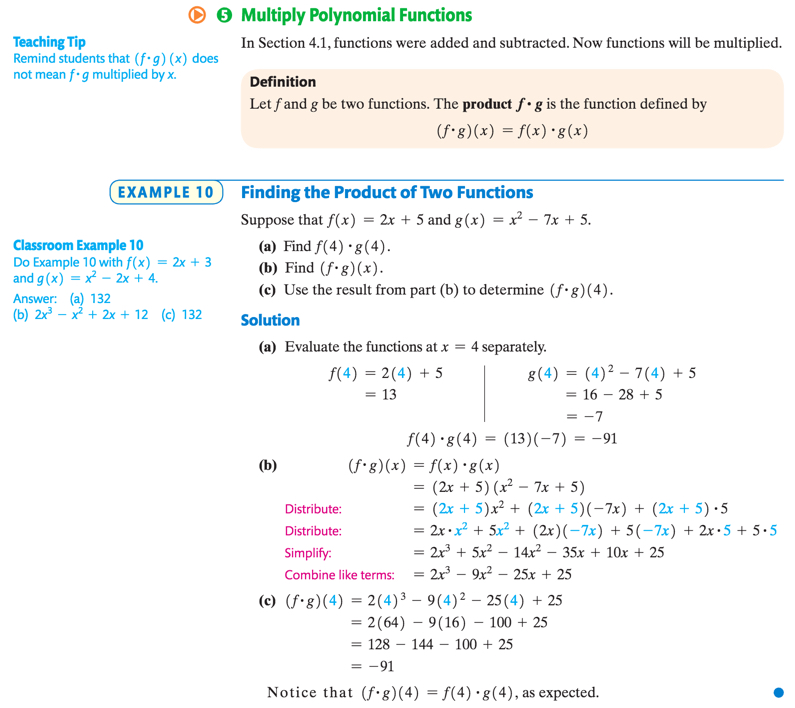
Now in the Fourth Editions of Intermediate, Elementary, and Elementary & Intermediate Algebra
These texts were initially written prior to the release of MyMathLab. As MyLab Math has increased in popularity, we have noticed that students have been using MyLab as the primary source of content (not the text). My experience in the classroom caused me to realize that MyLab needs to be a tool for learning, not just assessment.
So, we asked with this revision, “How can we utilize the MyLab features while retaining the features of the text that help students to learn?”
The author-team decided to write our own MyLab Math course, which is available to you.
In the course, each section has two levels of homework. Part I of the assignment is where the learning takes place (historically was the role of the textbook); Part II of the assignment is where the assessment of the learning takes place.
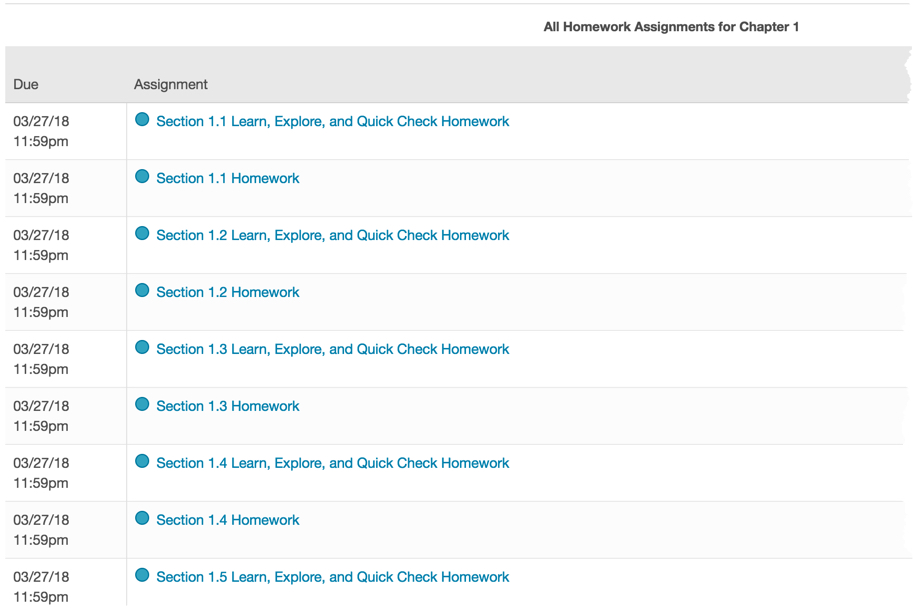
Part 1. We named the first part of the homework Learn, Explore, Quick Check (THE TRAINING WHEELS)
This is where the learning takes place.
In Part I the students are asked to watch the Author in Action Videos (actual classroom lectures). They can take notes as they watch the videos in the Guided Video Notebook. All objectives have a video – sometimes more than one video to keep them under 10 minutes. Note: The Author in Action videos may also be accessed using a Quick Response (QR) code at the beginning of each section in the text.
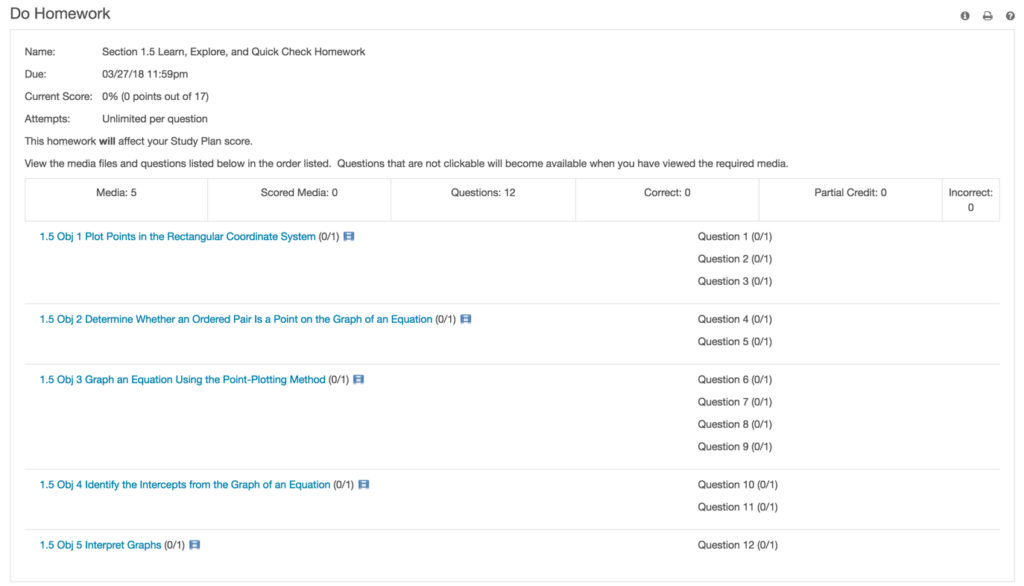
Also included in this portion of the homework are How To (or Guided) Exercises. These exercises are modeled after the Showcase exercises from the text (think of this as a graded Help Me Solve This) and were written by the author team.
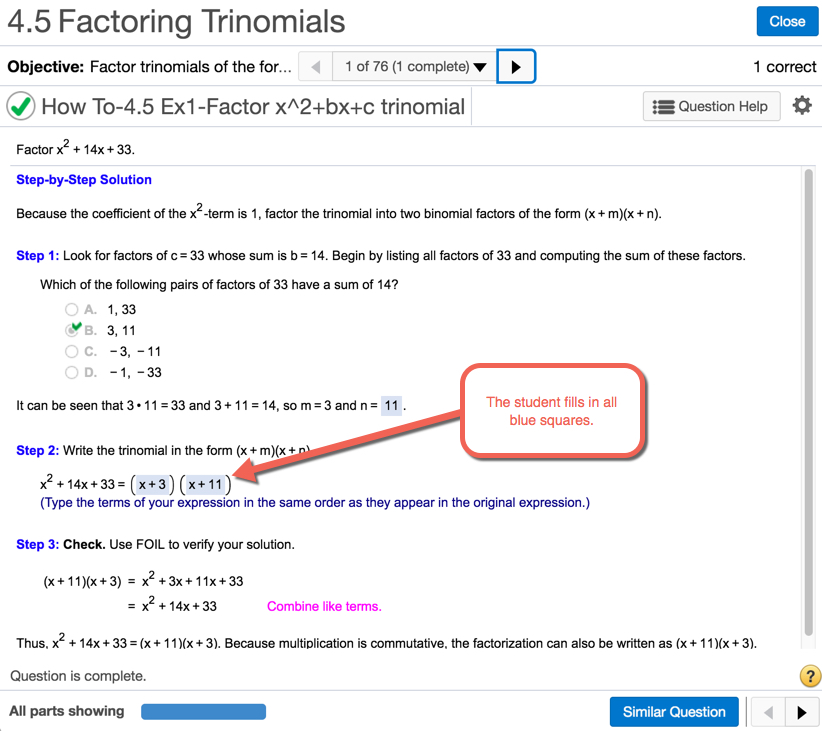
For example, this is the How To exercise that corresponds with the How To Example 1 in Section 4.5 of Intermediate Algebra. Notice Step 1 of the solution process is given to the student and then the student is asked to answer a question (that is, do the math!). MyLab then gives the student feedback on his/her response. The student is engaged throughout the entire problem and therefore is more likely to understand the steps that were presented and be able to use these steps to solve other problems.
Continuing with the Learning portion of the course, select sections have discovery interactive applet exercises. Students are asked to use the applet to discover properties on their own. Experiential learning is excellent for developing understanding. The applets and corresponding exploration exercises were also written by the author team.
In this particular applet exercise, the student is expected to use the applet and corresponding exercises to discover the properties of slope. Here, two points are plotted and the slope is determined. Here, the slope is positive and the line moves up and to the right. (Skiing uphill).
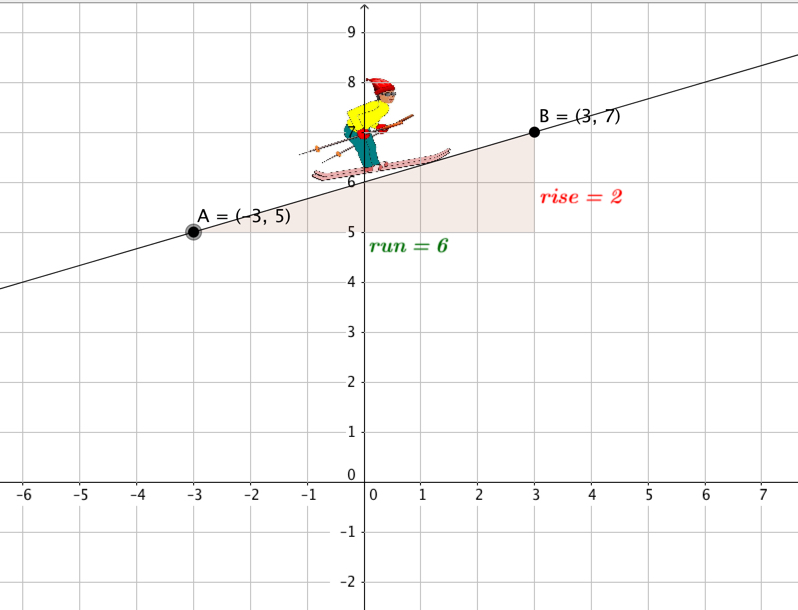
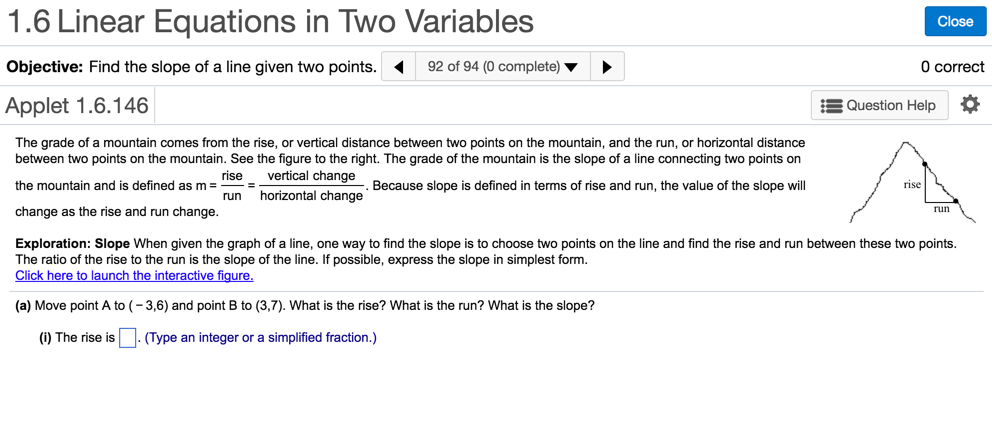
The last component of the learning portion is the Quick Check exercises for the text. One frustrating feature of MyLab for me was that students would not use the Textbook Learning Aid because this aid only takes the student to the beginning of the section. Students would still need to search for the example that is similar to the problem they are working on. We resolved this issue because the Textbook learning aid now goes directly to the example that the Quick Check exercises follow.

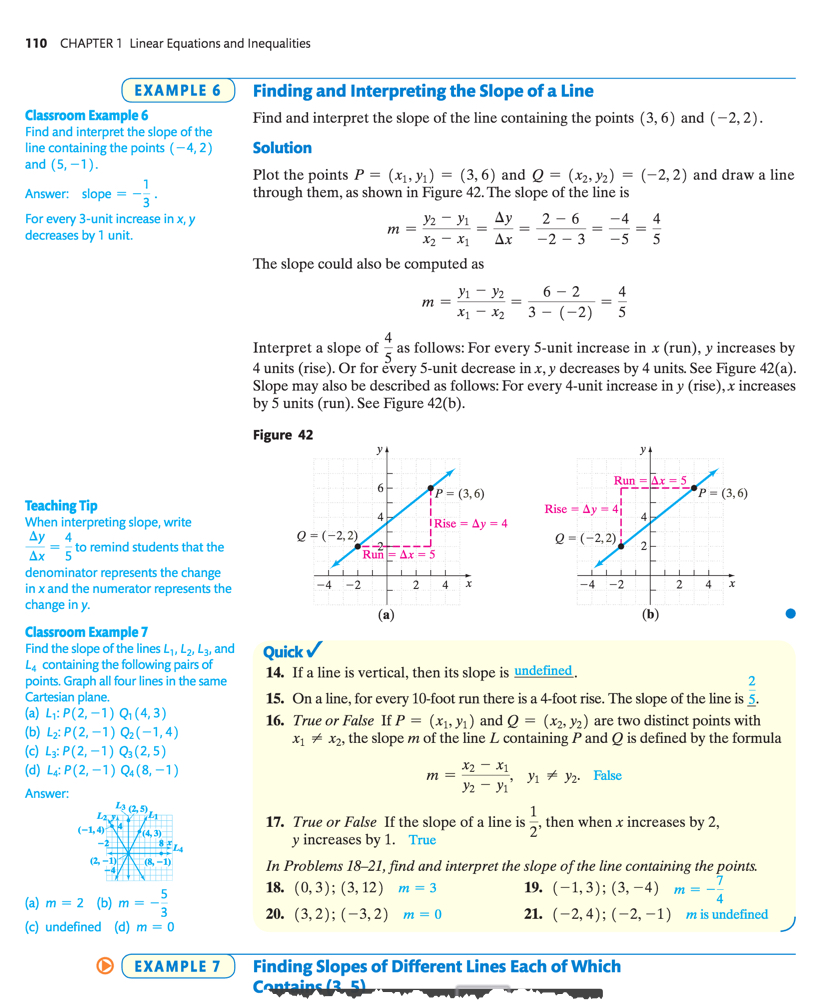
This means the Quick Check exercises in MyLab may be utilized as they were intended when we first wrote the text. If an instructor assigns Quick Check exercise 20, for example, and the student clicks the Textbook Learning Aid, the page that Quick Check is located on will open. The student will know to review Example 6 from the text. With this Learning Aid, students are much more likely to use the text within MyLab.
Part 2. Think of this part of the homework as Assess Your Understanding
While Part 1 homework is for learning (think of it as training wheels on a bike), Part 2 homework has the training wheels come off. We have two types of skill-based problems here. 1. Building Skills – specifically tied to an objective. Textbook learning aid goes to the objective. Metaphor – Parent holding the child’s back while riding without training wheels. 2. Mixed Practice and Applications. Textbook learning aid goes to the beginning of the section. Child is on his/her own.
Throughout Part 1 and 2 homework, the View an Example Learning Aid is disabled. I have found that students use this aid as a crutch and develop a false sense of understanding as they mimic the View an Example steps. Then, when test-time comes, they do not succeed. Given a false sense of content knowledge.
Bear in mind that the homework problems were selected based on analytics learned from the previous edition. Most important – we used the median time to complete an assignment to assure that the sections’ assignment should take the typical student about 90 minutes. This is consistent with the “two hours outside of class for every hour in class” mantra of mathematics educators.
We do encourage instructors to turn on the Skill Builder feature with the Part II homework.
I want to give credit where credit is due. Many of the new features in the MML course were developed by Jessica Bernards and Wendy Fresh. Both are technology gurus who are also power MyLab users. The implementation of the author-team’s ideas is attributed to their talents.
Learn More
There are four texts in this series. Click on each title to learn more.
- Developmental Mathematics 2e – this is a 3-in-1 solution that contains PreAlgebra, Elementary Algebra, and Intermediate Algebra
- Intermediate Algebra 4e
- Elementary Algebra 4e
- Elementary and Intermediate Algebra 4e
